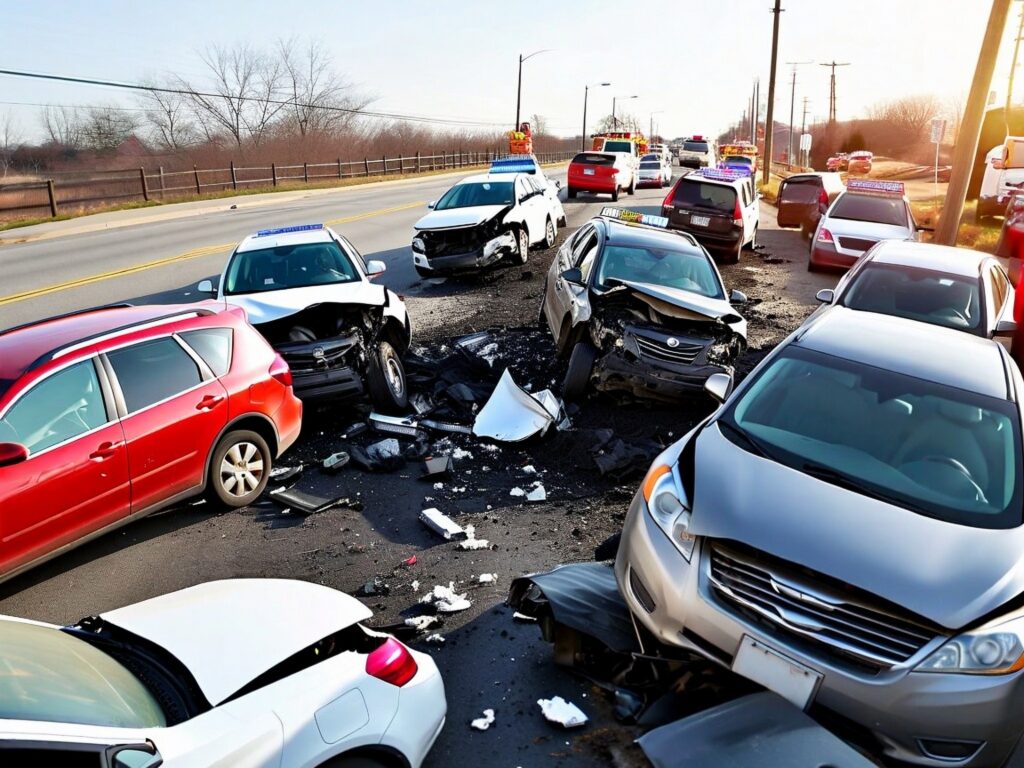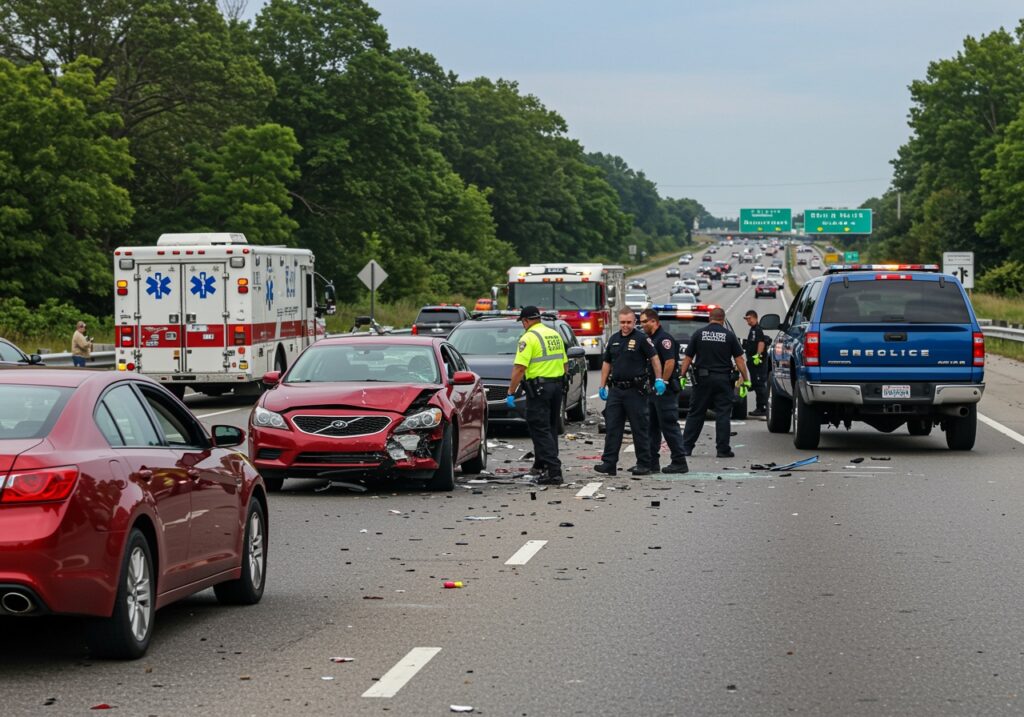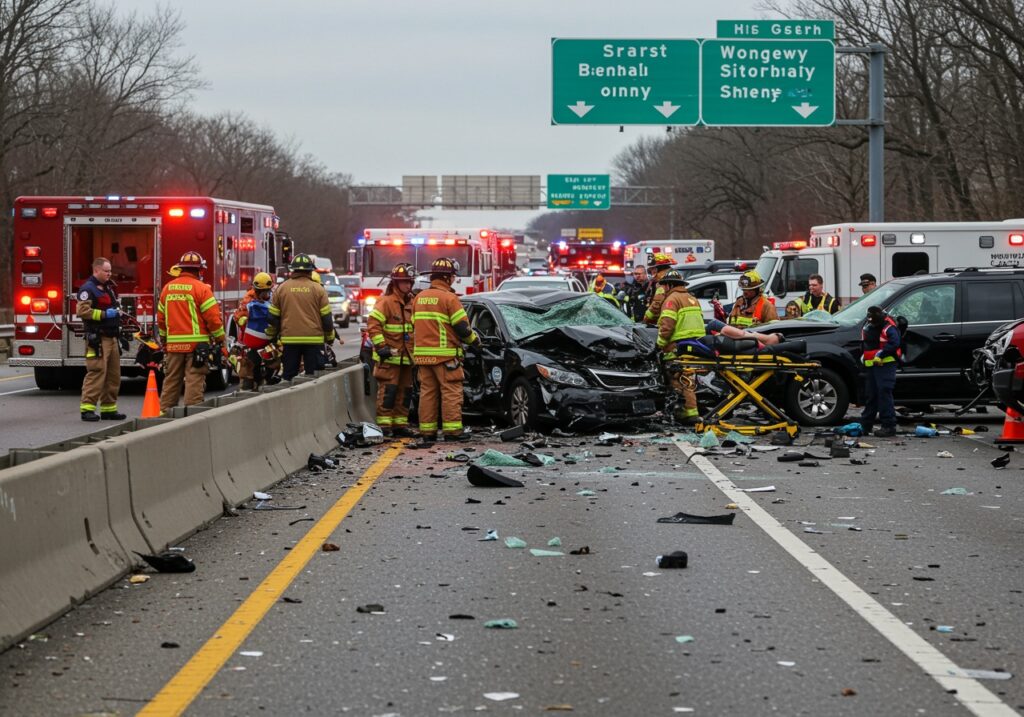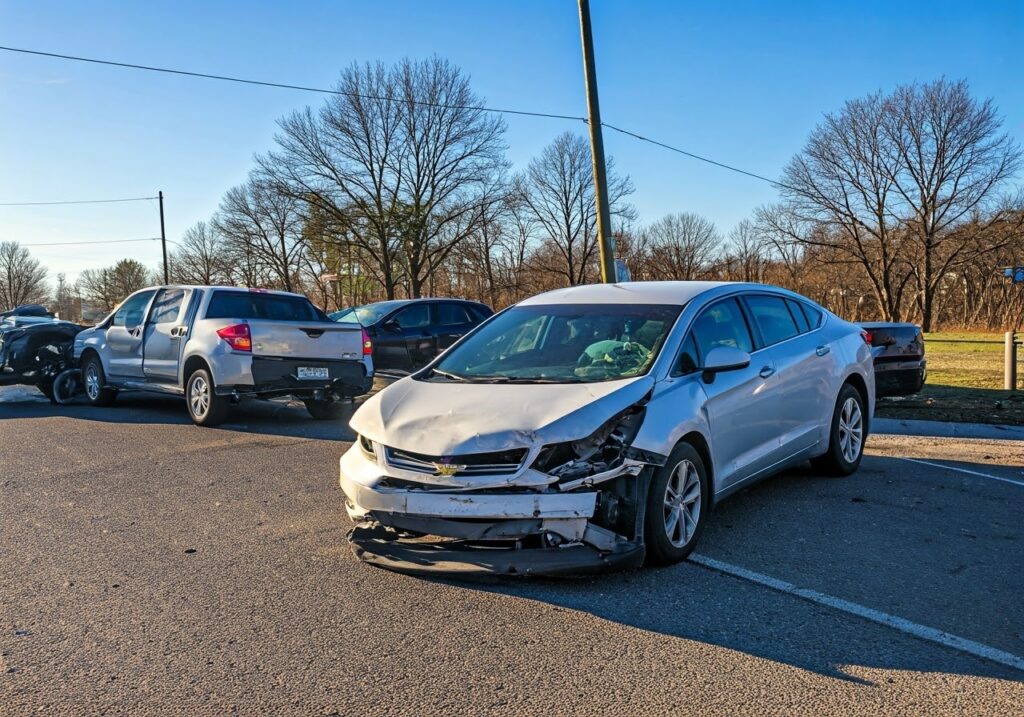
Dealing with the aftermath of a car accident can be difficult. You may be juggling appointments and repairs, all while you are unable to work or dealing with a newfound disability.
Our attorneys put your recovery first, seeking damages for your injuries, compensation for lost wages, and coverage for other bills and expenses. We also work to get your pain and suffering, emotional distress, and other non-economic damages, which often means taking the at-fault driver to court.
For a free evaluation of your injury case, call our car accident lawyers at The Carrion Law Firm today at (631) 910-7493.

Determining Fault in a Long Island Car Accident
If you were hit by another driver, your first fear might be that you get blamed for the crash. New York uses a no-fault car insurance system, which can help you get paid without even needing to prove fault. However, fault will still be vital in your case when it comes to getting full damages paid.
No-Fault Coverage
New York’s car insurance system is called a “no-fault” system because your coverage should pay for you regardless of whose fault the accident was. However, this is only a portion of the coverage on your car insurance policy.
To cover “basic economic loss” drivers carry PIP insurance – personal injury protection. This covers up to $50,000, divided among covering your medical care, part of your lost wages, and necessary expenses. While that might cover a good portion of your damages, these damages can easily peak above this coverage, and there is no PIP coverage for pain and suffering.
Why Fault is Important
Instead, you usually need to make claims for pain and suffering – along with property damage/vehicle repairs – against the at-fault driver. Property damage pops up in every car accident case, and pain and suffering is present any time you are injured enough to go to the hospital, so these damages are vital.
There are limits on when you can claim these damages, but, importantly, you also need proof that the other driver was responsible before you can get any damages from them.
When is a Driver “At-Fault”?
Drivers are considered at fault any time they violate a legal duty and it causes your accident or injuries. Most of these “breaches” of duty come from a traffic violation, such as speeding, driving drunk, tailgating, or running a red light. Alternatively, driving unreasonably also violates the duty to drive as a reasonable driver of ordinary prudence would – a duty we are all bound to follow when we get behind the wheel.
Some accidents are caused by many breaches. This can lead to multiple drivers – including the victim – each being accountable for a percentage of the fault. This same percentage is the percent of the total damages they will pay, with victims losing out on their own share of damages.
If there is anything that “cuts off” their fault – such as another driver interfering – someone else might be at fault instead, so it is vital to review your case with a car accident attorney and sue the right parties.
Sometimes accidents are unavoidable under the circumstances – e.g., with bad weather – and it might be a true “freak accident” where no one was at fault. These are rare, though, and we can often find someone to blame for your accident.
If no one was at fault, your PIP/no-fault coverage still applies.
Other At-Fault Parties
Other people aside from the driver might be at fault, but this is limited.
The most common defendants to add are the driver’s employer. If they are a truck driver or delivery driver or were otherwise driving for their job, their employer can be held liable in their place. The employer might have also done other things – like failed to maintain the vehicle – making them personally responsible.
Car owners can also be held liable this way in limited cases, such as when a friend borrows a car the owner knows is dangerous.
Auto part manufacturers can also be held liable for defective or dangerous parts, and local governments can be liable for some dangerous road conditions, though these cases can be difficult.
Passengers usually are not at fault, even if they were distracting the driver. The only way they typically become at fault is if they actually grabbed the wheel and made themselves the legal driver.
The “Serious Injury Threshold” for Car Accidents
One important restriction to understand is the “serious injury threshold” for crashes. As mentioned, there are limits on when you can make a claim against the at-fault driver for pain and suffering or other damages. The “serious injury threshold” is the line between cases you can sue for and cases where your PIP will have to suffice.
Suing for Pain and Suffering
Injured drivers and passengers cannot sue for pain and suffering or other damages not covered by their PIP unless they have “serious injuries.” This term is defined under I.S.C. Law § 5102(d).
This “threshold” must be met before you can sue or file a third-party insurance claim against the at-fault driver. When you sue them, you can get pain and suffering, along with other damages. In a third-party insurance claim, their liability insurance pays for your damages, including pain and suffering.
“Serious Injuries” List
Many states have a narrow “serious injury” rule, but § 5102(d)’s definition is quite broad.
Most “serious injuries” involve permanent injuries, injuries that affect your bodily functions, or loss of an organ/body part. Amputation always qualifies, as would something like reduced function or partial loss of an organ like your liver or bowel. Even if you did not lose a body part, permanent impairment or limitation also qualifies, such as a crush injury so bad that you cannot use your hand anymore.
Scarring is permanent in most cases, but you can only sue for scarring if it involves “serious disfigurement.” This would likely include obvious facial scars, serious burns, or widespread scarring, along with other injuries that permanently alter the shape of your face or body.
Injuries that will be disabling for at least 90 of the next 180 days after the crash are also “serious,” but you need evidence from a doctor confirming this.
One thing that truly broadens this category is that any fracture or broken bone also qualifies you.
Lastly, the most serious injuries – death or loss of a fetus – also qualify for the family of the deceased to file a lawsuit.

Suing vs. Insurance Claims for Long Island Car Accidents
Because of our no-fault system, you will likely file a claim with your own insurance first, then try to sue or file an insurance claim with the at-fault party. This creates some confusing aspects of insurance that might make you think you cannot sue when you can. At the same time, there might be insurance that can help you even if you ultimately plan on suing.
Whose Insurance Covers What?
As mentioned, your PIP insurance is no-fault coverage that will pay you regardless of who caused the crash. You can file a “first-party” claim with your insurance since you are the policyholder.
When you do this, you do not “settle” the case and lose out on the right to recover more damages later. However, if you later recover damages your insurance already paid for, you typically have to pay your insurance back from your winnings.
The at-fault driver’s “liability” insurance covers the damages they cause you, and you can file a “third-party” insurance claim with that policy. This is only possible if you meet the serious injury threshold.
When you file against the defendant’s insurance, it will pay for any damages it can cover: medical bills, lost earnings, pain and suffering, etc.
Suing the Defendant
When you sue the at-fault driver, the money they pay typically comes from their insurance. In fact, their insurance usually provides their defense lawyer, too. This means that whether you take them to court or go through their insurance, their insurance pays you.
When you go to court, the judge decides the laws that apply, and the jury decides what happened and how much the case is worth. This takes the decision away from the insurance company – who will be biased toward their driver – and gives it to a neutral party.
If you get to the end of your trial, the jury decides how much the case is worth, and the judge enters the judgment. This ends the case.
However, if you already settled with the defendant directly or accepted money from their insurance, that would have ended the case earlier.
Settling the Case
If you settle with the defendant or their insurance company, you cannot go back to court for more damages. The case is over once you settle, and the paperwork will include a release where you give up your right to more money.
Because of this, you should always work with a car accident lawyer to negotiate your settlement. Settling can often pay you full damages if you have a strong case, but your lawyers should advise you on whether the settlement is enough.
At the end of the day, the vast majority of injury claims do settle, whether before trial, in pre-trial stages, or during trial.
Getting Damages if the Defendant is Uninsured or Underinsured
If the defendant does not have insurance, it might be hard to make them pay for your damages. However, your insurance might help step in.
Suing Uninsured/Underinsured Drivers
Because the defendant is personally responsible for what they did, you can still sue them even if they do not have insurance. However, without their insurance paying for the damages, you are limited to what they can afford to pay you.
If they are independently wealthy, they can probably cover it all. If they were working as a commercial driver, their employer might also be able to pay for the damages. However, most people cannot pay out of pocket, which is what insurance is for.
The same issues can arise if the driver is insured but their insurance does not cover your full damages. If you get payment from your insurance first, then get their insurance on top of that, it might be enough. However, if you are still short, you can potentially sue the driver for them to pay for the rest out-of-pocket.
Uninsured/Underinsured Motorist Coverage
The more likely scenario is that you have insurance to help. Your uninsured/underinsured motorist coverage (UM/UIM) is required to meet the same standards as your liability coverage for state minimum insurance:
- $25,000 for one person’s injuries
- $50,000 for all injuries in the accident.
Hit and Runs
Uninsured motorist coverage also covers hit and runs on Long Island. For these, you first exhaust your PIP coverage, and then, if you cannot find the hit and run driver, you turn to your UM/UIM coverage. You do not have to use your UM/UIM if we ultimately find the driver, but finding a hit and run driver is not always possible.
Damages for Car Accident Victims on Long Island
There are a few major areas of damages we have touched on, but it is worth going into them in detail, along with additional categories:
Medical Bills
Medical bills can be incredibly expensive, even for moderate or minor injuries. A hospital stay could bankrupt many drivers, and it is vital that we have insurance and lawsuits to cover these costs.
When you claim damages for your crash, you can get coverage not only for your emergency care and hospital stays but also rehabilitation, pain medication, physical and occupational therapy, mental health therapy, and more. As long as the treatments were related to your accident, they should be covered in your damages.
Lost Earnings
Any income you miss because of the crash should be paid back. If you needed time away from work to recover, get surgeries, or go to therapy, all of that lost income must be covered.
If your case involves ongoing disabilities that keep you from working at full capacity, we can project your future lost earnings. This means looking at the difference between what you would have made without the injury and what you can make now.
If your income is reduced by a partial disability, this will account for that. It could also represent the income lost from total disability.
Lost wage payments are necessary to keep yourself and your family going after a serious, life-altering injury and to pay you back for minor/moderate injuries.
Expenses from Accident
Other expenses that you would not have paid without the accident should also be covered. This can be something as simple as hospital transportation or the cost of a babysitter while you are in the hospital. It can also pay for household services and daily activities you need replacements for, such as sending out your laundry or hiring a maid if you are too injured to do these tasks.
These and the other damages discussed above are all “economic damages” with bills, receipts, or financial records showing their value.
“Non-Economic Damages”
In contrast, other damages with no monetary value can be claimed as “non-economic damages.” The name “pain and suffering” might be used interchangeably, as that is the most common type of non-economic damages.
These damages can only be claimed if you have serious injuries under NY law.
Other terms like “emotional distress” or “mental anguish” help describe some of the things covered under this category. You can also get payments for the lost enjoyment of activities – e.g., if you were an avid bike rider before the accident or can no longer pick up your children because of your injury. Lastly, damages for serious scarring or burns might be important.
Punitive Damages
Punitive damages are sometimes – though rarely – available to punish bad actors. Defendants whose actions were beyond “negligent” and into “reckless” can often be ordered to pay extra to punish them and deter future similar behavior.
Our attorneys can sometimes claim these damages against repeat bad actors, companies with a track record of dangerous drivers, and other similar defendants. All in all, these damages are not typical.
Calculating Damages for Long Island Car Accident Cases
Our attorneys can calculate your economic damages by adding up all the bills, receipts, and other expenses you faced. This seems simple, but it is much harder to account for future damages like ongoing medical bills and future lost earnings. There are also two typical calculation methods for non-economic damages.
The first method is the “multiplier method,” which sets a multiplier value based on how serious the injury was overall. This might mean something like a broken bone is a 1, but something like a brain injury leading to ongoing disabilities is a 4. We then multiply all of your economic damages by this value to get your non-economic damages.
Alternatively, the “per diem” method sets a daily value for your pain and suffering. This is easier to use when you have already recovered and have a set number of days of pain and suffering to claim. Otherwise, we can project the number of days.
Once we arrive at a starting value, we can always adjust up or down.
The jury’s final calculation of damages may be different. We can present our claim for how much we think the case is worth, and the defense might argue a lower value. Ultimately, it can be hard to predict whether the jury might award you even higher damages if they feel you were badly wronged.
Calculating Settlements
Most car accident cases settle without trial, meaning we will need to calculate how much you should get in your settlement. The same principles apply from calculating damages: add up all expenses, project future costs, and calculate pain and suffering. However, we also have to take into account that we are settling.
You might have a better chance of higher damages at trial, which means a settlement might lose you damages. Your settlement will also depend on the strength of your evidence, with defendants possibly settling higher if your case is strong.
Going to trial also costs more in legal expenses, exhibit prep, and expert witness testimony. Settling could mean lowering the costs, thus lowering the damages proportionately. Your lawyers can help you account for these things and negotiate with the defense to ensure they are not taking advantage of these reduced costs to reduce your settlement.
Early settlements are usually bad in car accident cases. Instead of paying what your case is worth, they often try to pay just under what it would cost them to fight the case. This is a discount to them and should usually be rejected, with your lawyer negotiating for higher damages.

Proving a Car Accident Claim on Long Island
Your case will need evidence of what happened and what damages you faced. These damages need to be proven “by a preponderance of the evidence,” meaning that the jury believes your claim is more likely than not. The following evidence helps with each part of that proof:
Proof of What Happened
Evidence will usually involve witness testimony to say what happened leading up to and during the crash. Remember that the parties are also witnesses and can testify.
Other evidence can back up your story, such as photos of vehicle damage and the crash scene. Additionally, video from nearby security cameras or vehicle dashcams provides excellent proof of how the accident happened.
Police might be able to testify about the aftermath or statements the defendant made, but if they did not witness the crash, they might not be able to testify about it.
We can also use expert witnesses when necessary, such as accident reconstruction experts.
Proof of Damages
Most of the proof of damages comes from bills and records of the expenses. Any future expenses can be based on these.
We may need financial experts to testify about future costs and job prospects for future lost earnings. Similarly, medical experts might be able to testify about future medical costs.
Lastly, we prove your pain and suffering with your own testimony and statements from loved ones, doctors, and therapists about the effects of the accident.
Call Our Car Accident Lawyers on Long Island Today
For a free case evaluation, call The Carrion Law Firm’s car accident lawyers at (631) 910-7493.

